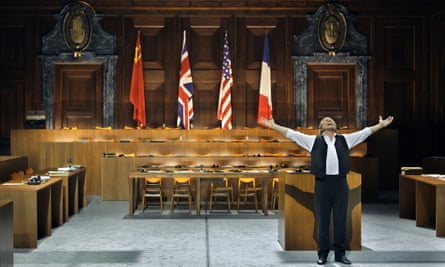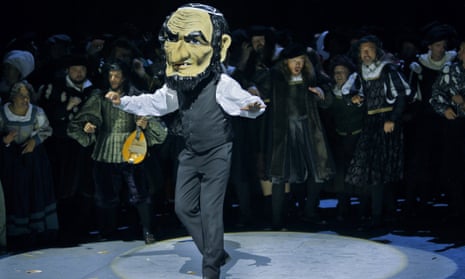Richard Wagner is directly responsible for two important buildings in the Bavarian town of Bayreuth. The first is the Festspielhaus theatre, to which Wagner devotees and the German elite flock each summer for the Bayreuth festival. The second is Haus Wahnfried, in which the composer and his family lived (and where he is buried in the garden) and which has recently reopened as an extended museum.
Barrie Kosky is not the first director to have the idea of putting the two icons together by placing Wahnfried on the Festspielhaus stage, as he does in his new production of Die Meistersinger von Nürnberg, which opened the 2017 festival this week in front of an audience that included Angela Merkel.
Stefan Herheim did the same thing in his landmark 2008 production of Parsifal. But Kosky is the first to put Wagner himself on the stage as well. That’s because Kosky’s Meistersinger is not really about Nuremberg in the familiar sense – it is about Wagner. The usual Nuremberg settings are absent from this production. There is no St Katherine’s church congregation in Act One, no riotous night-time street scene in Act Two and no cobbler’s shop in Act Three. The production’s only visual allusion to the place where the opera is set is to the Nuremberg Trials of 1945, in which the world sat in judgment on the Third Reich.
This production, in contrast, sits in judgment on Wagner. Act One is set in his Wahnfried house. Wagner is on stage almost throughout, in multiple guises from child to adult, but principally as the opera’s central character, Hans Sachs. At the heart of this Meistersinger is an imaginative, subtle and serious staging of a simple question: how far does Wagner’s antisemitism invalidate his artistic achievement? In the end, Kosky proves to be a fair judge of a question that is still necessarily debated.
That question still hangs over Bayreuth and Wagner alike. And note the formulation. Not “Does it?” but “How far does it?” Note also the predicate. Kosky takes Wagner’s antisemitism as a fact, not a theory. In Act One, the Jewish conductor Hermann Levi (who conducted the 1882 Parsifal premiere) visits Wagner at Wahnfried, is insultingly treated by the composer and evolves into Beckmesser, the opera’s buffoon and victim. At the end of Act Two, Beckmesser is beaten up, not as usually happens as collateral damage in the nocturnal mayhem, but because he is – and Wagner has made him – a Jewish stereotype. A giant antisemitic puppet fills the stage and then deflates, taking any trace of the opera’s traditional Merrie Deutschland with it.

Sachs as Wagner and Beckmesser as Levi aren’t the only historical elisions. The young knight Walther becomes another, younger, Wagner. Eva, in love with Walther, morphs into the composer’s second wife Cosima. Pogner, Eva’s father, becomes Franz Liszt, Cosima’s father, who mimes the overture on the grand piano. The other mastersingers, here portrayed as undifferentiated clots, are got up to look like Albrecht Dürer’s self-portrait. Confused? It gets that way sometimes. You need A-level Wagner to get the most out of this show.
Kosky loves a busy stage picture – the mind boggles at what he will do with Carmen at Covent Garden next season – and this production has plenty of them. But in acts two and three, he proves his sensibility by giving the piece more room to make its own musical case. By the time it gets to Sachs’s pivotal Act Three “Wahn” monologue about madness and mayhem, the scales begin to tip towards a more musically driven verdict on Wagner. In the final scene, normally full to the brim with colour and pageantry, Sachs/Wagner stands completely alone on stage, before the backdrop lifts, revealing an orchestra and chorus which he conducts for the final ensemble. Music wins in the end but it is never a foregone conclusion. Wagner leaves the court of Kosky with a conditional discharge.
As this implies, the level of collaboration and connection between pit and stage is crucial. Philippe Jordan’s supple conducting is moulded around Kosky’s staging, with some daring pauses, and the Bayreuth orchestra and chorus are superb. Even by his own standards, Michael Volle has never sounded more probing and sensitive as Sachs; his monologues are models of tonal control and expressivity. Johannes Martin Kränzle is almost his authoritative equal as Beckmesser, more than ever the key role in this production, and rendered without vocal or dramatic caricature.
In a largely German cast, the tenor Klaus Florian Vogt shows again why he remains the Walther of the day, the ethereal, strikingly individual, tone pouring out of him as the Prize Song takes shape in Act Three. Anne Schwanewilms is a bigger-voiced Eva than most, and she gives the character a compulsive skittishness that verges on the demented. Daniel Behle is a stock David. Günter Groissböck a notably fine Pogner. But it is Kosky’s evening.

Musically, Bayreuth festival standards remain strikingly high, as Christian Thielemann’s lush but beautifully balanced conducting of this year’s revival of Tristan und Isolde underscored. Stephen Gould’s tirelessly well projected Tristan and Petra Lang’s impassioned Isolde led the soloists, with the luxury casting of René Pape’s King Marke, Christa Mayer’s Brangaine and Iain Paterson’s Kurwenal ensuring the kind of high Wagnerian singing standards that have mostly been Bayreuth’s trademark down the years.
Dramatically, though, things are less predictable. In 2015, Katharina Wagner’s Tristan staging impressed with its focus on the clash between obsession and power. Two years on, its defects, which culminate in King Marke’s brusque and possessive snatching away of a still very alive Isolde from the body of Tristan at the end of the Liebestod, seem more designed to shock than illuminate. There is much to admire about the Katharina Wagner reign at Bayreuth, not least the renewed readiness to face up to Bayreuth’s own Nazi and antisemitic history. Artistically, however, she has had an uneven start since she took over following her father’s death in 2010. But Kosky’s Meistersinger is a reminder that Bayreuth can still score palpable dramatic hits too.

Comments (…)
Sign in or create your Guardian account to join the discussion